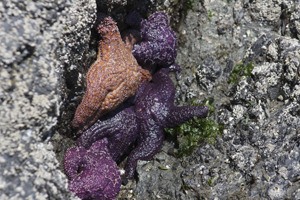By Russel Barsh and Madrona Murphy
The size, symmetry, and bright colors of starfish attract attention, and of all the strange animals in the inter-tidal zone, starfish are among the strangest. When we meet children on the beach, starfish always lead to the most questions.
The most frequently asked question is why the commonly seen, five-armed ochre star comes in so many colors. Purple to pink, orange and tan, ochre stars are all a single species. Ochre stars are not alone. Only one starfish species that you are likely to see in inter-tidal zone is always the same color: the short-spined star is always a conspicuous bright pink.
Many hypotheses have been tested and failed to find a function for starfish color variation. Since starfish cannot see color (starfish have eyespots on the tips of their arms but they only sense light levels), color variation cannot influence the way starfish interact with each other. In other marine species, color is used for camouflage, but starfish colors actually make them more conspicuous. Is color a warning to potential predators? Many starfish produce saponins (soap-like compounds) that make them bad tasting, if not toxic. But why is a single starfish species multi-colored? Is one bright color not enough?
Color variation might confuse predators. What eats starfish? Other starfish, such as two of our largest, 12 to 24 armed starfish – soft and spiny sunflower stars and leathery red Dawson’s sun stars. Astonishingly, seagulls sometimes tear arms off of starfish, or even swallow starfish whole – an amazing but uncommon sight.
Most of our shallow-water starfish eat mollusks such as clams, mussels, limpets and snails, however. They can crush thin shells with their five teeth, or grasp a clam in their arms and slowly apply pressure until the clam’s adductor muscle – the muscle that holds clamshells closed – is exhausted: a kind of arm wrestling match.
Starfish can even evert their stomachs and exude digestive enzymes into a partially opened clam, making it easier to open by converting the insides of the clam into chowder!
Short-spined stars, sand stars and sunflower stars can use their arms to excavate clams buried in sand or mud. Sunflower stars sometimes congregate and troop along the sea floor, leaving behind barren sands dotted with small pits and bits of clamshell. While sun star barrens look lifeless, the effect is temporary. Sun stars may serve the same kind of function as wildfires or windstorms in forests, opening ground for re-colonization by other species.
But how do starfish “walk” on the bottom? We are used to seeing starfish at rest, firmly attached to a surface. But starfish are not very dense, and they do not need a lot of energy to move when they want to, propelled by thousands of tiny tube feet with suction cups on their tips. Tube feet are hydraulic: they are moved by pumping water into them and out again. Ochre stars move rather slowly (about a foot per minute), but sunflower stars hit their stride at about three times that speed, and there is one report of sand stars traveling at an astounding nine feet per minute.
Can starfish grow arms back? Generally yes. Many starfish, including the sand stars and sunflower stars found around the islands, can discard (autotomize) an arm to escape a predator. Some starfish can regenerate a new body from a single detached arm. There is even a tropical starfish genus (Linckia) that reproduces by detaching its arms!
Even with the power of regeneration, starfish do not live forever. Our common ochre star is one of the longest-lived species, with a potential life span of about 30 years.
As a group, starfish are likely to survive, if not benefit from, climate change and ocean acidification. Clams, snails and other mollusks must use a lot of energy to build, maintain and enlarge shells made of calcium carbonate, which dissolves in acid. Like us, starfish have a protective outer layer of skin. Although starfish skin is stiffened by small bits of calcium carbonate called ossicles, ossicles are surrounded by tissue like our bones, not simply exposed to the environment. On the other hand, the mollusks that starfish eat will be easier to open, if ocean acidification weakens their shells!
For more info, visit www.kwiaht.org.




